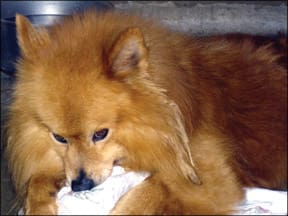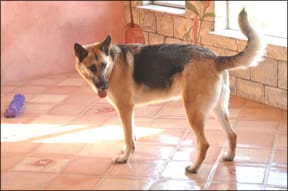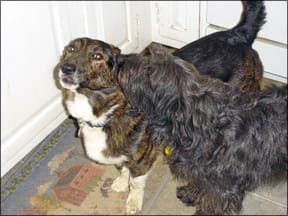[Updated January 10, 2019]
CANINE OCD: OVERVIEW
1. Manage your dog’s world to maximize structure and consistency and minimize stress and the likelihood she will develop compulsive behavior.
2. Be on the lookout for any signs your dog is developing a compulsive disorder and address them immediately if they appear.
3. Avoid engaging in behaviors with your dog that are likely to elicit compulsive disorder such as chasing a flashlight or laser beam, or reinforcing tail-chasing.
4. If your dog has an established obsessive compulsive disorder, seek the help of a qualified behavior professional, and realize that effective treatment will probably include the use of behavior modification drugs.
Owners of herding and sporting breeds – Border Collies, Aussies, Kelpies, Labradors, Goldens, and others – often cheerfully talk about their dogs’ “obsession” with tennis balls. What they really mean is that their dogs are very reinforced by the opportunity to chase a ball.

That kind of intense interest in a ball or toy can be useful for training and management purposes, and it’s definitely not what we’re talking about when we use the term “obsessive compulsive disorder” or OCD. An OCD can be a difficult and debilitating behavior for you and your dog to live with; it’s not a cause for cheerful discussion.
What is Obsessive Compulsive Disorder in Dogs?
Also called canine compulsive disorder (CCD) and compulsive behavior disorder (CBD), OCDs have been defined by behavior researchers Drs. Andrew Luescher and Caroline Hewson as, “Behaviors that are usually brought on by conflict, but that are subsequently shown outside of the original context . . . Compulsive behaviors seem abnormal because they are displayed out of context and are often repetitive, exaggerated, or sustained.” Dr. Luescher, a veterinary behaviorist and director of Purdue University’s Animal Behavior Clinic, estimates that about 1 dog out of 50 suffers from canine compulsive disorder. Luescher and Hewson suggest that examples of environmental stressors that can trigger compulsive behaviors include:
– Physical restraints such as close confinement and chaining.
– Social conflicts that arise from competition for status, changes in social group, or separation.
– An unpredictable or uncontrollable environment.
– A lack of target object for normal behavior. For example, a dog kept isolated has no normal outlet for its instinct to interact within a group, whether animal or human.
Common OCDs include behaviors such as spinning, tail chasing, fly snapping, shadow chasing, air licking, flank sucking, pica, persistent barking, and “hallucinating.” Despite the intriguing names for these behaviors, they are not fun for a dog or for his humans. In fact, they can make life pretty miserable, and are evidence that the dog is living in an environment that is stressful for him.
Much of the underpinnings of OCDs are still a mystery to the veterinary medical and behavior world. There is evidence that suggests while they are all neurologically based, they are not all caused by the same physiological phenomenon; there may be several different classes of OCDs. Results of studies suggest that locomotive disorders such as spinning, and oral disorders such as licking, are controlled by different parts of the brain. Still, all of the different classes appear to be related to conflict resulting from stress or arousal, and all seem to respond to similar treatment.
According to Steve Lindsay in his Handbook of Applied Dog Behavior and Training, Volume Three: Procedures and Protocols, “Dogs most prone to develop compulsive behavior problems are frequently high-strung and impulsive . . . Highly motivated and high-strung dogs who are intolerant of conflict and frustration seem to be particularly at risk for developing compulsive habits.” It would stand to reason that dog breeds whose propensity for intense motivation has been enhanced by selective breeding – such as the herding and sporting breeds – would be more prone to compulsive behaviors.
Indeed, there is a genetic component to the propensity to develop OCDs, and certain breeds do have a predisposition for certain compulsive behaviors. It has been suggested that seizure activity may play a role in triggering canine compulsive behaviors, but there is no scientific evidence to support that theory, and most behaviorists agree the primary culprit is stress. Dr. Andrew Luescher was quoted in a January 7, 2010, ScienceDaily article saying, “You could probably make every dog have compulsive disorder if you provide enough threats or conflict.”
A Menu of Obsessive Compulsive Canine Behaviors
The following are some of the more common canine obsessive compulsive disorders.
LOCOMOTIVE
Spinning: Dog turns in place in rapid circles.
Tail chasing: The dog turns in place in rapid circles, but appears to be focused on his tail.
Shadow or light chasing: Chases light reflections with extreme intensity; fixates on possible light sources.
Pacing: Repetitive movement back and forth in a straight line – can be walking or running. Often seen in zoo animals and dogs in kennels, or along line fences.
ORAL
Fly snapping: Dog snaps randomly in air, apparently at invisible objects. Seeing a flying insect may spark the behavior, but it persists when insects are not present.
Pica: Ingesting inappropriate objects (far beyond normal/expected chewing) – sometimes to the point that emergency surgery is need to remove objects, such as stones, acorns, or socks.
Chewing or licking self: Dog licks and/or chews feet, legs, or anywhere on body; can cause the development of “lick granulomas,” sores, or dermatitis. If your dog is a chronic tail biter, other underlying problems may be present.
Air or nose licking: The dog licks at the air in front of his face.
Licking others or objects: Dog persistently licks humans, other dogs, blankets, toys or other objects.
Polyphagia or polydipsia: Dog eats or drinks excessively, resulting in excessive defecation and/or urination. There is sometimes a medical cause for these behaviors, but sometimes it is OCD.
Flank sucking or object sucking: Dog sucks on his own flank or on toys, blankets, or other objects.
VOCALIZATION
Persistent howling or rhythmic barking for no discernible reason.
AGGRESSION
Inexplicable self-directed aggression – attacking hindquarters, legs, tail; attacking food bowl and other inanimate objects.
What to Do with an OCD Dog
As with any undesirable behavior, you’re better off not letting an OCD become established in the first place. Whether you have a breed that is prone to OCD or not, you can dodge the bullet by keeping your dog in a well-structured environment with a regular routine, and avoiding introducing obvious stressors such as yelling at, hitting, or alpha-rolling your dog. If, despite your best efforts you do see the glimmerings of OCD behavior, you’ll have greatest success in extinguishing it if you address it immediately rather than waiting until it’s full-blown.
Your attention can reinforce an OCD behavior. Tail-chasing is often perceived as cute by owners who laugh and praise the dog and encourage the behavior. OCD tail-chasing is not cute. Fortunately, it can sometimes be extinguished in early stages by removing all attention.
I had clients whose four-month-old Golden Retriever pup had OCD pica and had already had one emergency surgery to remove pebbles and acorns from his stomach. When Corky showed interest in chasing his tail, I counseled his owners to immediately leave the room as soon as he started the behavior. (Dogs with one OCD often easily adopt another.) Within a few weeks the tail-chasing had stopped.
There are a number of things you can do to reduce general stress levels for your dog. Prophylactic stress reduction can prevent OCD, and reducing the dog’s stress in the early stages may extinguish it. But reducing the dog’s stress (as part of a complete behavior modification program) can reduce even well-established OCD behaviors. Stress-reducing tactics include:
– Explore, rule out, or treat medical conditions that might contribute to stress, including thyroid. (See “Help for Dogs With Hypothyroidsim,” June 2005.)
– Increase exercise on a consistent schedule. This is an important one. Not only does exercise use up energy that might otherwise feed OCD behaviors, but aerobic exercise promotes endorphin release, which has a calming effect.
– Train your dog. Training helps your dog understand what’s expected of him, and what you are communicating to him. His world makes more sense, so it’s less stressful to him. If your dog is trained and responds to your requests for behavior, it’s less stressful for you as well, and you’re less likely to be tempted to punish him, which is, in turn, less stressful for him.
– Use plug-in, spray, and collar-infused Dog Appeasing Pheromones (DAP/Comfort Zone). DAP is a synthetic substance that mimics the pheromones emitted by a mother dog when she’s nursing her pups. It has a calming effect on a significant number of adult dogs.
– Play “Through a Dog’s Ear.” These bio-acoustically engineered CDs feature soothing classical music, and have been clinically demonstrated to reduce canine heart rates. (They calm people, too!)
– Make sure your dog is on a high-quality (or at least good-quality) diet.
– Utilize products such as Doggles (canine sunglasses) to reduce visual stress, the Thundershirt and the Anxiety Wrap to reduce environmental stress.
– Apply calming massage or T-Touch, in conjunction with aromatherapy. If your dog associates calming touch with the scent of lavender, that scent can be used at other times to help evoke calmness.
OCD and Stress in Dogs
With any stress-induced behaviors, including OCDs, your first assignment is to identify and reduce as many of your dog’s stressors as possible. Of primary importance is identification and removal, if possible, or at least management, of the proximate cause of the dog’s stress or conflict.

Following that, you want to address all stressors, not just the one(s) that seem to trigger the OCD behavior. Most households can identify a list of 10 to 20 stressors for their dogs. A short list might look like this:
1. Being crated
2. Small children
3. People and/or dogs walking past the front windows
4. Nail trimming
5. Riding in the car
6. Threats to his resources
7. Thunder
8. Prong collar
9. Verbal and/or physical punishment
10. Owner stress
Decide which of the following strategies you can effectively apply to each stressor on the list to reduce its effect on your dog’s overall stress level:
– Use counter-conditioning to change the dog’s opinion of (that is, his association with) the stressor.
– Teach the dog a new, incompatible behavior using operant conditioning.
– Manage the dog’s environment to reduce his exposure to the stressor.
– Get rid of the stressor.
– Live with it.
You could get rid of crating stress simply by not crating the dog anymore. Or you could change his opinion by giving him a new, positive association with the crate. You could use counter-conditioning to help him like children, or, if there aren’t children in the home, you could simply manage them as a stressor by removing him when children are around. You can manage your dog’s arousal at passers-by simply by blocking his access to the window, and you can also counter-condition his response so he no longer becomes aroused. You could also teach him a new behavior, so that someone walking by the window is his cue to go lie down on his rug in the kitchen.
Stressors 4 through 7 are also good candidates for counter-conditioning. You could manage thunder stress with the use of anti-anxiety medication and a Thundershirt.
Stressors 8 and 9 fall into the “get rid of it” group. Stop using a collar that causes pain and stop doing bad things to your dog and his stress is guaranteed to decrease. By themselves those two stressors could be the proximate cause for a compulsive disorder.
Stressor 10 is a “live with it.” Just be aware that when you are stressed (any stress; it doesn’t have to be dog-related) that you add to your dog’s stress load, and it is likely that you will trigger one of your dog’s OCD incidents.
When to Call A Veterinary Behaviorist
Of course, removing stressors alone is not likely to “fix” most well-established OCDs. Chances are quite high that all the above steps to reduce stress and promote calm won’t be enough to extinguish your dog’s OCD behavior.
You can try removing reinforcement for the behavior, and you can try positively reinforcing an alternative behavior that’s incompatible with the OCD (sit, instead of spin, for example). However, it’s well-accepted in the behavior field that a serious compulsive behavior almost always requires intervention with behavior modification drugs.
For this, you need a veterinary behaviorist, or at least your own veterinarian needs to work in close consultation with a veterinary behaviorist. The use of psychotropic drugs is complex and requires a thorough education in the field – it’s not acceptable for a veterinarian to reach for the first behavior drug that the last pharmaceutical company salesman talked him into buying.
Also, I cannot stress strongly enough the critical importance of working with a board-certified veterinary behaviorist when it comes to selecting, administering, and monitoring the use of drugs for your dog’s compulsive disorder. Virtually every veterinary behaviorist will do free phone consultations with other veterinarians, so there’s no excuse not to. There are fewer than 50 of them in the United States.

How Common is Dog OCD?
So what are the chances, really, that you’ll need all this information about OCDs? I think Dr. Luescher’s estimate of 2 percent of the canine population might be quite conservative. In our pack of five dogs, only Dubhy, the Scottie, shows a total lack of OCD tendencies. That’s a whopping 80 percent in our household!
Bonnie, our Scorgidoodle, likes to lick others incessantly. Exercise goes a long way toward minimizing her annoying licking behavior, as does reinforcing an incompatible behavior. (Here, Bonnie, chew on this orange. She loves oranges.)
Scooter the Pomeranian will lick objects, especially blankets or sheets. This behavior has decreased significantly since we adopted him over a year ago. A lot of his stress, I’m sure, had to do with all the upheaval and uncertainty in his tiny world. (He was left to fend for himself on the streets, then spent weeks in a noisy shelter. And even though he has a nice home with us, it’s been stressful for him to have to adapt to living with four dogs who are two to four times his size!)
Lucy, the Cardigan Corgi, will engage in spinning if she doesn’t get enough exercise. She spun during her shelter assessment after being confined to the shelter kennel for several days, and started spinning here on two separate occasions when she was on “restricted activity” for medical reasons. Usually, normal farm activity and occasional hikes are enough to keep the spinning demon at bay.
Missy, the Aussie, licks her feet and does air and nose licks. Her stress is probably a combination of multiple rehomings prior to coming to live with us, status conflicts with Lucy, and separation distress; we’re still working on those.
Please note: Our dogs all came to us from the shelter with these behaviors, so I’m not taking credit – or blame – for their compulsive behaviors!
Pat Miller, CBCC-KA, CPDT-KA, is WDJ’s Training Editor. Miller lives in Fairplay, Maryland, site of her Peaceable Paws training center. Pat is also author of several books on positive training, including her latest: Do Over Dogs: Give Your Dog a Second Chance for a First Class Life.







Hello. My name is Kate Ahern and Ilive in Townsville Australia with my husband, son and 2 Catahoulas. My elder dog, Riggs at 0 is fine but my younger Basil at 4 has issues. He has epilepsy which is treated with drugs and keeps him stable but not incident free. He has recently, in the last few months, developed a licking fixation, if not excessive grooming, then licking the air. He is a lovely dog, desexed and very loyal. I just wish I could figure out what this licking is about.